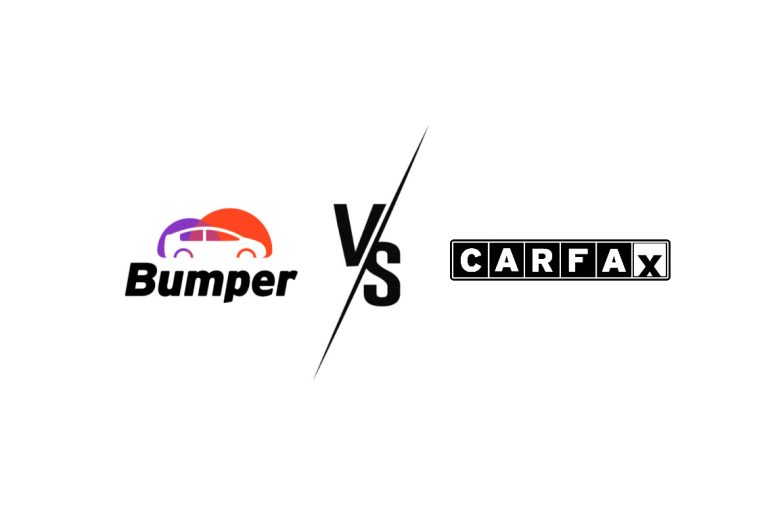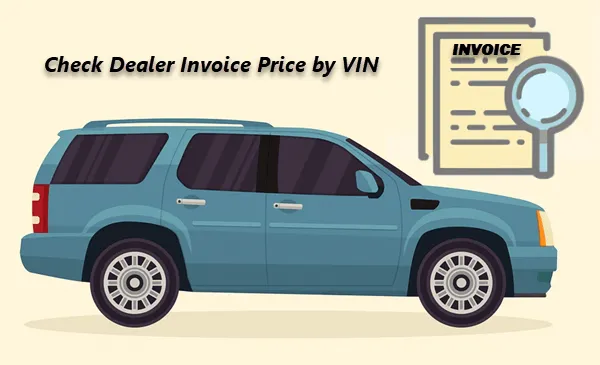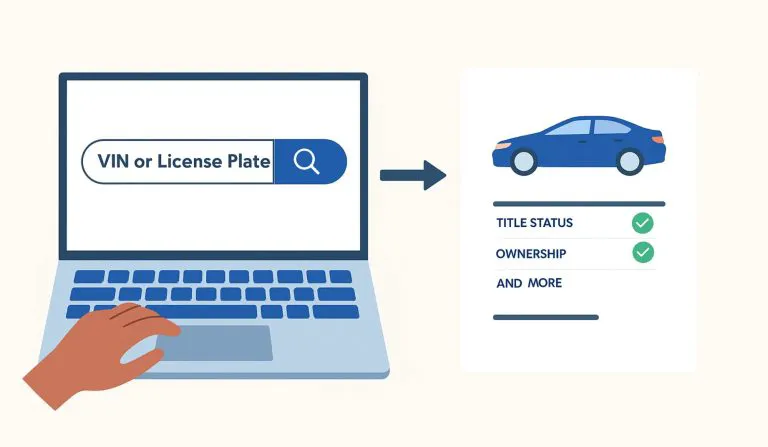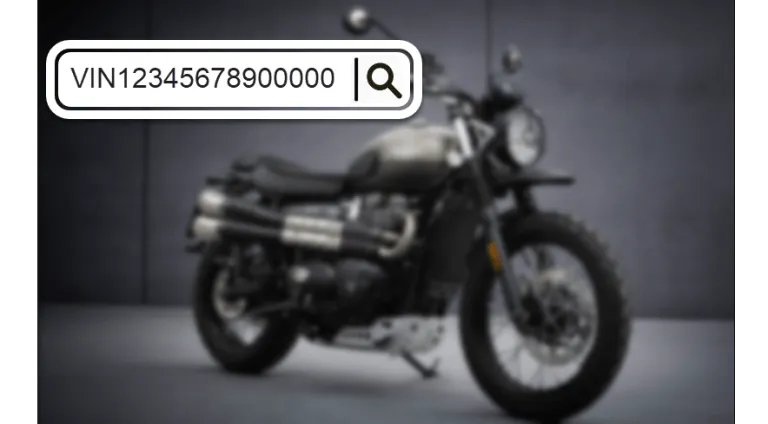How to check if a car has clean title (2025)
Buying a used car is not just about finding a good deal. It's also about making sure you're not inheriting someone else's problem.
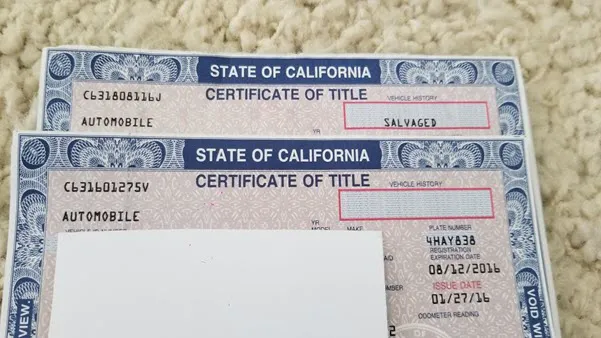
When you’re shopping for a used car, one of the most important things to check is its title. A clean title means the car is road-legal, usually more reliable, easier to insure, and holds better value when it changes hands. But just because a car looks clean doesn’t mean its title is. In this article, we’ll show you the most reliable ways to check if a car has a clean title. Read on…
4 Best Ways to Check for a Clean Title
- Check the certificate of title if you have it handy.
- For official, state-verified info, run a DMV title lookup.
- Need a quick title check with detailed vehicle history? Run a VIN check with Bumper.
- Just wondering if it was ever totaled or stolen? Try an NICB VINCheck.
What is a clean title for a car?
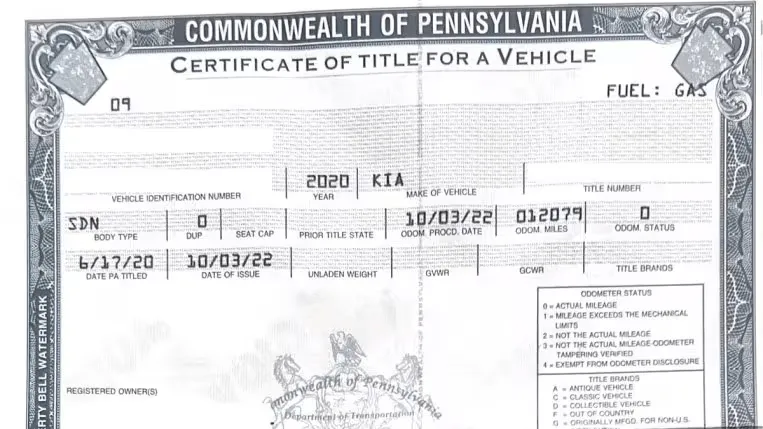
A car title is the official document issued by a state’s Department of Motor Vehicles (or equivalent agency) when a vehicle is purchased or registered1 to prove ownership of the vehicle.
All vehicles start with a clean title, indicating there are no prior damage markings or branding in the title status column. Essentially, a clean title means that the vehicle has not been labeled with any designations like salvage2, rebuilt3, odometer rollback4, or lemon buyback5. As such, it is roadworthy, legally eligible for registration, cheaper to insure, and generally poses fewer risks than vehicles with branded titles.
Having a clean title is a green flag, but it DOESN’T automatically mean the car is accident-free or flawless. If the damage was minor and properly repaired, it may still carry a clean title. In some cases, if the owner chose not to report damage or repairs, there may be no records at all. Additionally, what is branded in one state could be considered clean in another6. So, before you commit, it’s always important to pull a vehicle history report and have a mechanic do a top-to-bottom inspection to make sure everything checks out.
Is a clean-titled car free of debts or liens?
A clean title does not guarantee that the car is free of debts or liens. A vehicle with a “clean” history could still have an outstanding loan or other financial claims attached to it. This differs from a clear title, which confirms that the car has no financial encumbrances, such as unpaid loans or liens.
Method 1: Check the certificate of title
If you have access to the certificate, checking it is often the most straightforward and reliable way to verify a car’s title status.
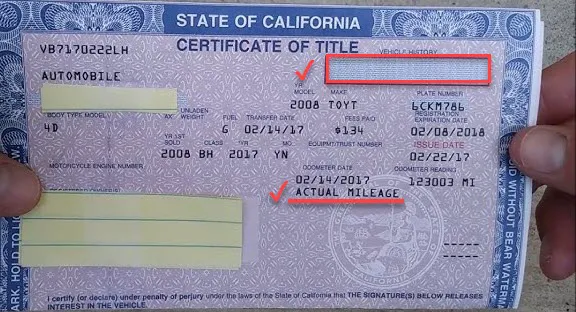
The certificate typically includes a section labeled “Vehicle History,” where title branding may appear, such as Salvage, Rebuilt, or Lemon. If this field is blank, it usually means the vehicle has a clean title.
Next, check the odometer section. Many titles include wording like “Actual Mileage,” “Not Actual,” or “Exempt7” to indicate the odometer reading status.
Last but not least, you may also want to check the registered owner’s name, issue date, title number, and liens to confirm the title’s validity and legitimacy.
If the title isn’t handy, lacks detail, or you just want to see what the DMV has on file, you can try Method 2, below.
Method 2: Run a DMV title lookup
The Department of Motor Vehicles (DMV) — or a similar state agency — is responsible for vehicle registration, licensing, and maintaining official title records. Using the DMV’s title lookup service is one of the most reliable ways to check if a car has a clean title, since the information comes directly from the official source.
To start, simply go to your preferred browser, enter title search + your state + DMV8.
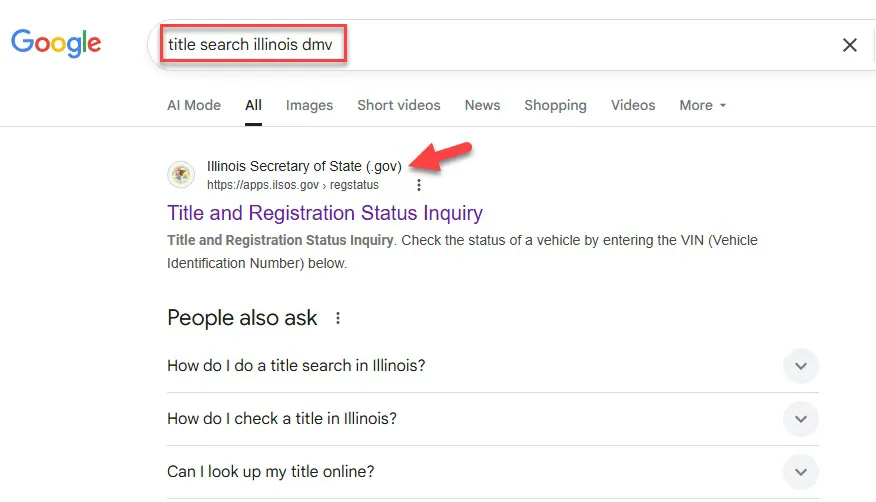
Once on the official site, look for the title or vehicle history lookup service, then input your VIN to start a title search. Depending on the state, sometimes you may be asked for additional details like the vehicle’s make, model year, or even to create an account or verify personal information to access title-related info.
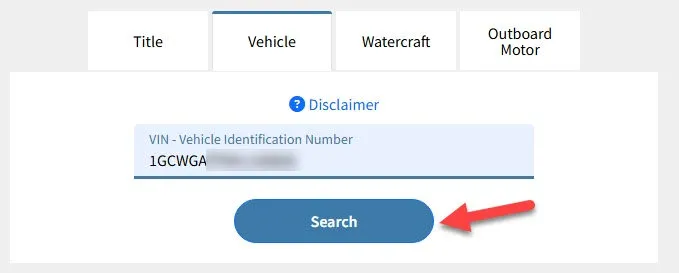
Some states, like Florida, Illinois, and Ohio, offer user-friendly online portals that provide detailed title data, including title type, title status, and other vehicle details.
For example, an Ohio BMV’s title report may include fields such as: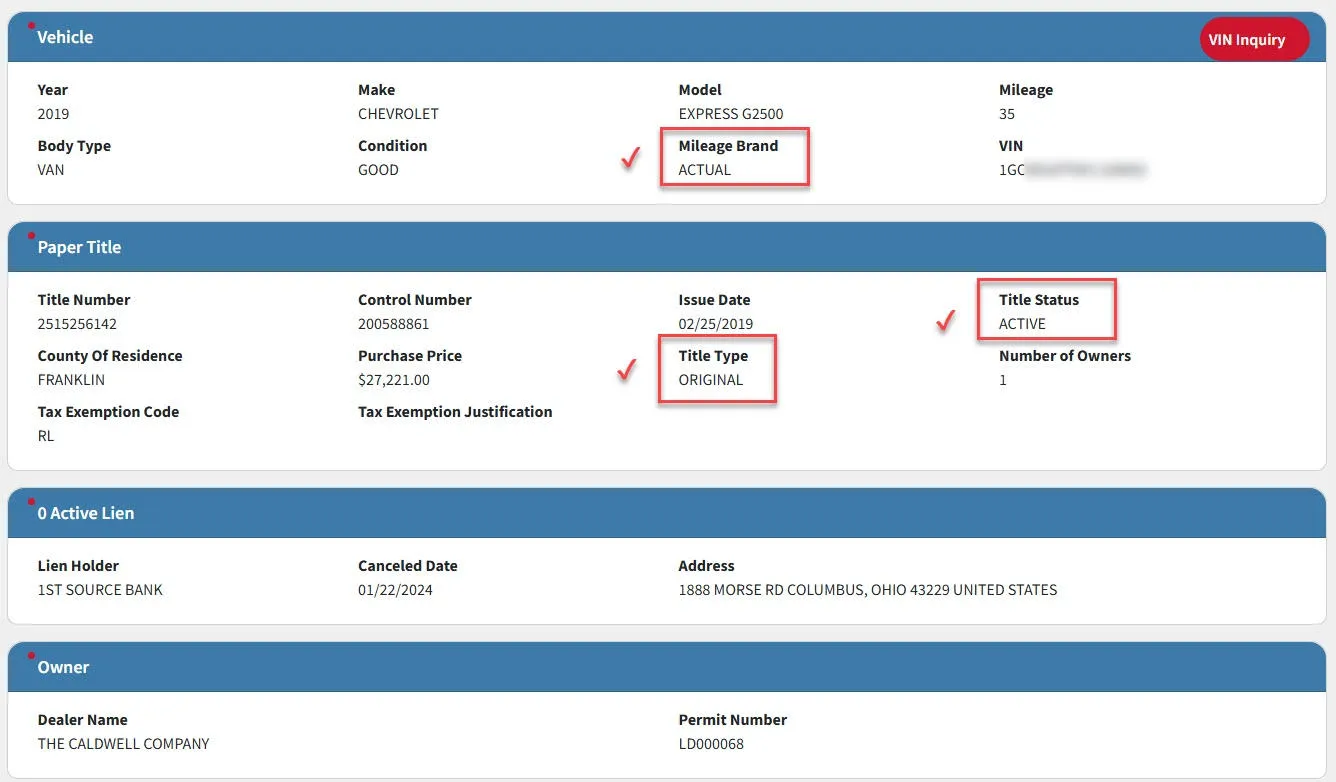
- Original: Indicates that this is the original title for the vehicle (i.e. not a duplicate, replacement, or salvage)9.
- Active: The title is currently valid and hasn’t been voided, transferred, or replaced.
- Actual (under mileage): Confirms the odometer reading is accurate and hasn’t been rolled back or tampered with.
With all of these checked, we can reasonably conclude that the vehicle has a clean title with no major issues reported.
However, many other states either don’t provide online title lookups or limit the information available. For these, you may need to submit a formal request or application to obtain the vehicle’s title history, which might involve a fee and processing time.
Method 3: Get a vehicle history report
Each state DMV keeps its own title database, but those only show the car’s current title status in that state. Since vehicles may cross state lines, get sold multiple times, or carry past title brands like salvage or rebuilt, a single-state DMV search may miss important details.
Fortunately, the National Motor Vehicle Title Information System (NMVTIS) was created as a federal database that aggregates title data from states, insurance companies, and salvage yards nationwide.

One of the easiest ways to access NMVTIS data is through Bumper. In addition to pulling from NMVTIS, Bumper also gathers information from accident databases, insurance records, and other industry sources. This makes it a powerful option for checking a car’s title and history.
All you need to do is go to Bumper’s official website, enter the car’s VIN or license plate number, and hit SEARCH.
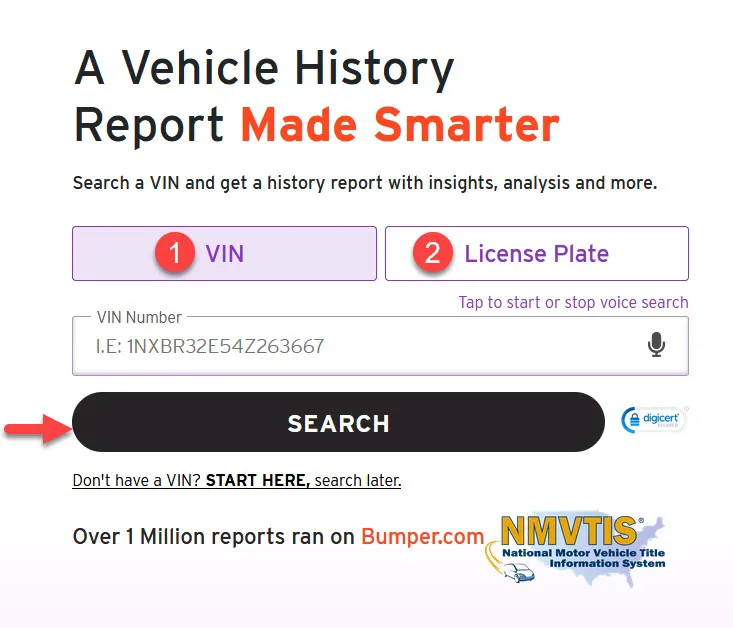
Bumper will start checking the query against its data sources. Once it locates a match, it will gather the associated records into a neat report for you. This may include title status, brand history, odometer readings, number of ownership changes, accident history10, and other useful tidbits.
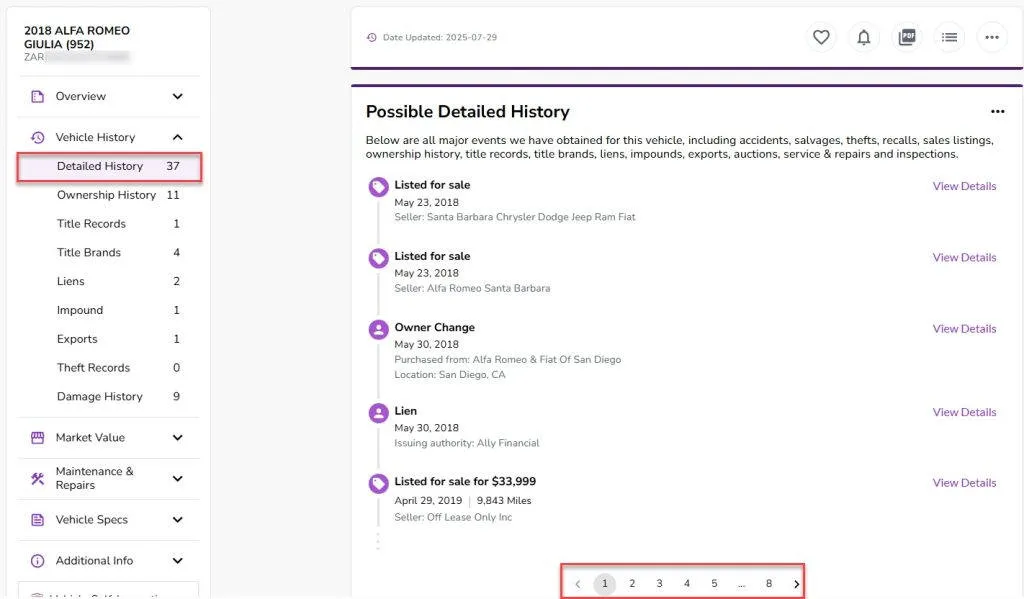
As you can see, this is a Bumper report: organized chronologically, listing key events like title updates, owner changes, accidents, and auction appearances (when available).
So where do you start?
- Review ownership history
Multiple owners aren’t automatically bad. But a high turnover rate, especially with short ownership durations (e.g. six months or less), can signal a problematic vehicle — maybe mechanical issues, undisclosed damage, or even someone trying to offload a car with a fresh branded title. Pay attention to where it was registered, too. A quick move between states may hint at title washing11. - Examine title records and brands
Look closely for brands like “Clean,” “Salvage,” “Rebuilt,” “Flood,” or “Junk.” Any brand other than clean usually sticks with the vehicle for good, even after repairs. - Watch for theft records
If the vehicle was ever reported stolen, that should be noted. Stolen-and-recovered cars may have hidden damage or tampered records, affecting the title’s reliability. - Examine odometer readings
Check for inconsistencies in mileage over time. A sudden drop may indicate rollback, while a large mileage jump could be a reporting error or a sign of misuse. A consistent, progressive odometer record helps confirm the vehicle’s history and supports the credibility of its title status. - Validate with other trusted sources
Even though Bumper pulls from NMVTIS, it’s good practice to cross-reference with other reputable providers such as Carfax and Autocheck.
Method 4: Run an NICB VIN check
The National Insurance Crime Bureau (NICB) offers a free VINCheck service that lets you quickly see if a vehicle has been reported stolen or declared a total loss by insurance companies. This helps catch hidden theft or salvage issues that might not appear in other reports.
To use it, simply visit the NICB VINCheck website, enter the car’s VIN, and submit.
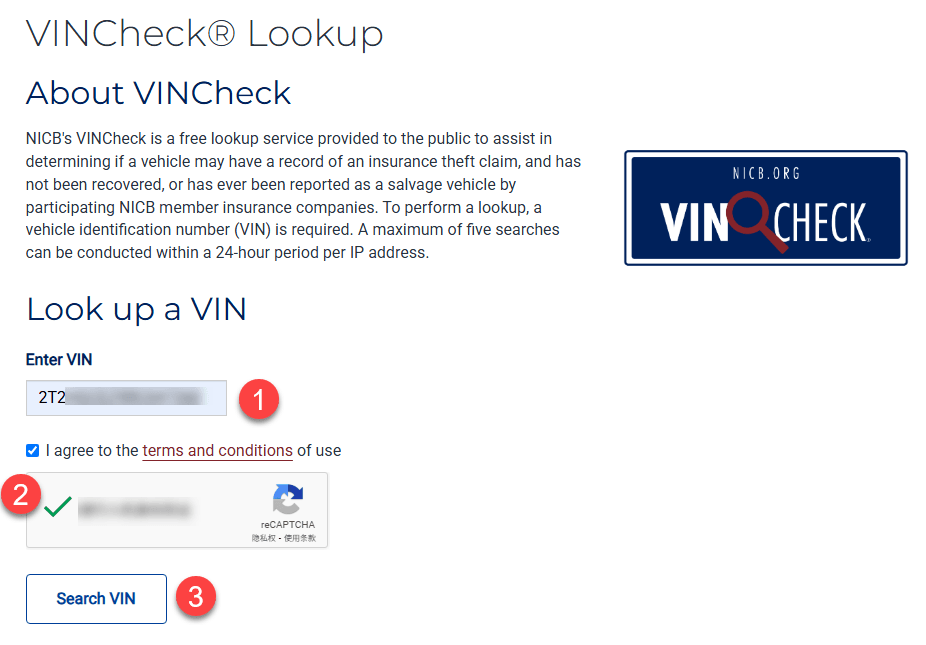
The system will search its database and tell you if the vehicle has any theft or salvage insurance claims on record.
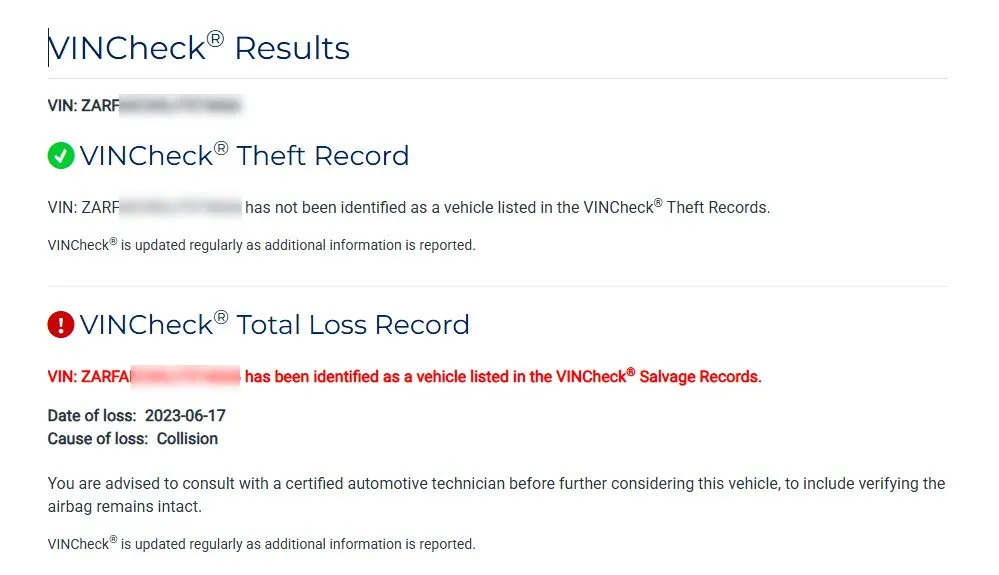
Keep in mind:
- NICB’s database only covers reported thefts and total losses from the past five years, so older incidents won’t appear.
- Not all insurance companies report to NICB, so the data may be incomplete.
- NICB does not include other title brands like rebuilt, lemon buyback, odometer rollback, or open recalls.
Wrap-up
Checking whether a car has a clean title is a crucial step in buying used. While a clean title usually means the vehicle hasn’t been totaled or severely damaged, it doesn’t guarantee it’s in perfect condition or free of liens. By combining these checks, you can get a clearer picture of the car’s backstory. And of course, don’t forget a thorough physical inspection. Sometimes, the real story is under the hood or behind the wheel.
- A car title can also be issued in cases such as title transfer, name change, or if the original title is lost.[↩]
- Salvage is a broad term that encompasses various forms of damage where the cost of repairs exceeds the vehicle’s market value. While salvage is the default term in most states, more and more states are adopting specific categories like water damage, hail, fire, non-repairable, or junk to more accurately describe the type of damage. [↩]
- Rebuilt refers to a vehicle that was previously declared salvage but has been repaired and inspected to meet state safety standards. While the car may be roadworthy, the salvage history is typically still reflected in the rebuilt title, and in many cases, this can impact the vehicle’s resale value[↩]
- Odometer rollback occurs when the vehicle’s odometer is tampered with to display a lower mileage than it has actually accumulated, potentially deceiving buyers about the car’s true wear and tear.[↩]
- Lemon buyback refers to a vehicle that was repurchased by the manufacturer because of recurring defects that could not be fixed within a reasonable number of attempts.[↩]
- States handle branding differently, which can create confusion. For example, a flood-damaged car branded as salvage in Florida might end up with a clean title in Texas—a common case of title washing due to inconsistent state rules. The specific title status depends on the state’s regulations, so it’s crucial to check how each state categorizes damage.[↩]
- “Exempt” typically applies to vehicles over 10 years old, where federal rules no longer require the odometer reading to be disclosed at the time of sale.[↩]
- Although most states use the term “Department of Motor Vehicles (DMV),” some go by different names. For example, Florida uses the Department of Highway Safety and Motor Vehicles, Washington refers to its agency as the Department of Licensing, and Ohio calls it Bureau of Motor Vehicles. That said, searching “[State] DMV” in most cases will still take you to the right place.[↩]
- According to the official Ohio Certificate of Title, the title type can be original, duplicate, replacement, salvage, salvage duplicate, or salvage replacement. clerk.franklincountyohio.gov[↩]
- Bumper reports are based on data available and may not include historical accident records in all states.[↩]
- Title washing is a malpractice where a branded title (salvage, odometer rollback, etc.) is concealed by registering the vehicle in a state that doesn’t recognize or report that brand.[↩]




 View all of Enya Zhang's posts.
View all of Enya Zhang's posts.
